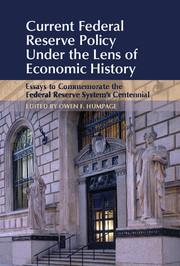 Current Federal Reserve Policy Under the Lens of Economic History
Current Federal Reserve Policy Under the Lens of Economic History Book contents
- Half title page
- Studies in Macroeconomic History
- Title page
- Copyright page
- Dedication
- Contents
- Contributors
- Discussants at the Conference
- Preface
- Introduction
- 1 The Uses and Misuses of Economic History
- 2 Federal Reserve Policy Today in Historical Perspective
- 3 How and Why the Fed Must Change in Its Second Century
- 4 The Lender of Last Resort
- 5 Close but Not a Central Bank
- 6 Central Bank Independence
- 7 Politics on the Road to the U.S. Monetary Union
- 8 U.S. Precedents for Europe
- 9 The Limits of Bimetallism
- 10 The Reserve Pyramid and Interbank Contagion during the Great Depression
- 11 Would Large-Scale Asset Purchases Have Helped in the 1930s?
- 12 A Tale of Two Countries and Two Booms, Canada and the United States in the 1920s and the 2000s
- 13 It Is History but It’s No Accident
- 14 Monetary Regimes and Policy on a Global Scale
- 15 Reflections on the History and Future of Central Banking
- Index
- Series page
- References
12 - A Tale of Two Countries and Two Booms, Canada and the United States in the 1920s and the 2000s
The Roles of Monetary and Financial Stability Policies
Published online by Cambridge University Press: 05 March 2015
- Half title page
- Studies in Macroeconomic History
- Title page
- Copyright page
- Dedication
- Contents
- Contributors
- Discussants at the Conference
- Preface
- Introduction
- 1 The Uses and Misuses of Economic History
- 2 Federal Reserve Policy Today in Historical Perspective
- 3 How and Why the Fed Must Change in Its Second Century
- 4 The Lender of Last Resort
- 5 Close but Not a Central Bank
- 6 Central Bank Independence
- 7 Politics on the Road to the U.S. Monetary Union
- 8 U.S. Precedents for Europe
- 9 The Limits of Bimetallism
- 10 The Reserve Pyramid and Interbank Contagion during the Great Depression
- 11 Would Large-Scale Asset Purchases Have Helped in the 1930s?
- 12 A Tale of Two Countries and Two Booms, Canada and the United States in the 1920s and the 2000s
- 13 It Is History but It’s No Accident
- 14 Monetary Regimes and Policy on a Global Scale
- 15 Reflections on the History and Future of Central Banking
- Index
- Series page
- References
- Type
- Chapter
- Information
- Current Federal Reserve Policy Under the Lens of Economic HistoryEssays to Commemorate the Federal Reserve System's Centennial, pp. 267 - 295Publisher: Cambridge University PressPrint publication year: 2015


